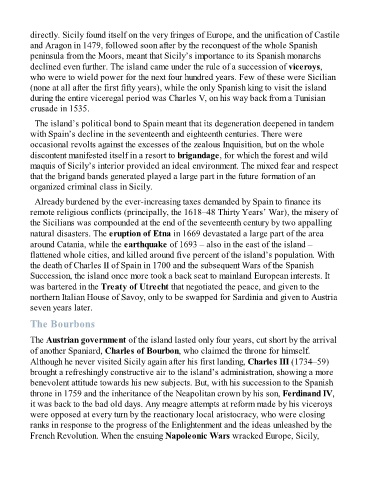Page 569 - The Rough Guide of Sicily
P. 569
directly. Sicily found itself on the very fringes of Europe, and the unification of Castile
and Aragon in 1479, followed soon after by the reconquest of the whole Spanish
peninsula from the Moors, meant that Sicily’s importance to its Spanish monarchs
declined even further. The island came under the rule of a succession of viceroys,
who were to wield power for the next four hundred years. Few of these were Sicilian
(none at all after the first fifty years), while the only Spanish king to visit the island
during the entire viceregal period was Charles V, on his way back from a Tunisian
crusade in 1535.
The island’s political bond to Spain meant that its degeneration deepened in tandem
with Spain’s decline in the seventeenth and eighteenth centuries. There were
occasional revolts against the excesses of the zealous Inquisition, but on the whole
discontent manifested itself in a resort to brigandage, for which the forest and wild
maquis of Sicily’s interior provided an ideal environment. The mixed fear and respect
that the brigand bands generated played a large part in the future formation of an
organized criminal class in Sicily.
Already burdened by the ever-increasing taxes demanded by Spain to finance its
remote religious conflicts (principally, the 1618–48 Thirty Years’ War), the misery of
the Sicilians was compounded at the end of the seventeenth century by two appalling
natural disasters. The eruption of Etna in 1669 devastated a large part of the area
around Catania, while the earthquake of 1693 – also in the east of the island –
flattened whole cities, and killed around five percent of the island’s population. With
the death of Charles II of Spain in 1700 and the subsequent Wars of the Spanish
Succession, the island once more took a back seat to mainland European interests. It
was bartered in the Treaty of Utrecht that negotiated the peace, and given to the
northern Italian House of Savoy, only to be swapped for Sardinia and given to Austria
seven years later.
The Bourbons
The Austrian government of the island lasted only four years, cut short by the arrival
of another Spaniard, Charles of Bourbon, who claimed the throne for himself.
Although he never visited Sicily again after his first landing, Charles III (1734–59)
brought a refreshingly constructive air to the island’s administration, showing a more
benevolent attitude towards his new subjects. But, with his succession to the Spanish
throne in 1759 and the inheritance of the Neapolitan crown by his son, Ferdinand IV,
it was back to the bad old days. Any meagre attempts at reform made by his viceroys
were opposed at every turn by the reactionary local aristocracy, who were closing
ranks in response to the progress of the Enlightenment and the ideas unleashed by the
French Revolution. When the ensuing Napoleonic Wars wracked Europe, Sicily,

